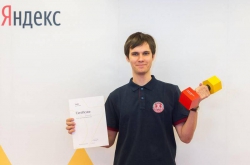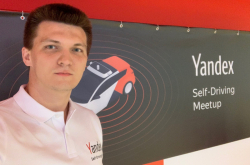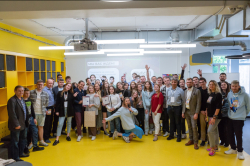The test was organized by Moscow Institute’s of Physics and Technology Extramural STEM School with support from the Yandex Company: anyone could participate in the test online using the Yandex.Contest platform. According to Roman Polozkov, research fellow for the ITMO's Department of Nano-Photonics and Metamaterials and one of the test's tasks authors, the idea of the event originated from a different project:
"Last year, Moscow Institute’s of Physics and Technology Extramural STEM School turned 50, so they've got the idea to gather graduates and ask them to "show how it's done". And then we thought: why not make an all-Russian event like the Total Dictation? So, this is how "Come Out and Solve!"came to be", commented Mr. Polozkov.
About 25,000 people registered for the test; yet, as the event has been held for the first time, many came to participate without registering. About 30 people — school students and adults alike -took the test at ITMO University.

The test consisted of modules in Math, Physics and Informatics; the participants had 50 minutes for each of them. All of the tasks could be solved using knowledge from secondary school's curriculum; the organizers didn't aim to impress anyone with extravagant tasks that called for advanced, university-level knowledge.
"The fact that many adults did not hesitate to come to the test is commendable as it is, so we didn't want to give really difficult tasks. We planned "Come Out and Solve!" as a science-popular event, where anyone could check his or her skills, not some intense contest. That is why the tasks were really versatile, and could be solved by using different mathematical and physical methods and approaches, so that participates could remember them", explained Roman Polozkov.
Most were focused on basic theory and formulas; yet, at the same time they could be solved with wits and logic, as well.
For instance, there was a task on finding the radius of a circle inscribed into a trapezium; values for some of the trapezium's sides and angles were given. To solve the task, one could calculate the remaining values for the trapezium, or draw a triangle inside it whose height would be the circle's radius, and calculate it using geometry formulas.
One of the tasks in Math could be solved without using any formulas at all. According to the problem's statement, two workers who work together can do the job in eight hours. Yet, one was late for three hours, so together,they had to work nine hours to compensate. The question was — how many hours would've the punctual worker spent on the job by himself? To do that, one had to correctly define the unknown variable to be used in the equation. Yet, the problem could be solved logically, as well.

The Math module contained tasks from numbers theory, tasks on percentage, and other. For Physics, the authors gathered tasks from different fields, as well — there were tasks on pneumatics, balance, physics of heat, and such. For instance, the participants had to calculate the time needed for water to boil, or power at different parts of a particular electric circuit.
The tasks in the Informatics module didn't call for advanced knowledge in languages of programming; to solve them, one had to understand the principles and logic of writing a code, as well as take note of regularities used for creating different sequences.
For example, in a task about two woodcutters one had to make an algorithm choose the better of the two. According to the statement, the better one cuts more trees. Yet, if both cut the same amount, the winner is the one who does it with fewer strikes. In another task, there were groups of words written in regular letters and words represented by zeroes and ones. One had to understand which sequences meant which letters, and then write down particular words in this binary code.
The results for the "Come Out and Solve!" test will be published on every participant's personal account in one or two days. According to the organizers, they are planning to repeat the event — so finding time to browse through your old textbooks and joining the test next year might be a great idea!





